A passion for photography and curiosity about the neighborhood drew Chicagoan Bob Rehak to Uptown. Over the course of four years, he captured what everyday life was like for neighborhood residents during the mid-1970s. Those photographs—now 40 years old—are being shared in a new book, "Uptown: Portrait of a Chicago Neighborhood in the Mid-1970s." Rehak shares his experiences documenting a diverse Chicago neighborhood with us.
“I always had a passion for photography, and I went by Uptown every day, twice a day, actually on my way to and from work. I was living in Rogers Park at the time and working downtown. I started my career as a copywriter at Leo Burnett and I always said, ‘you know I want to get off there, get off the L some day and take pictures of these people,’” Rehak said. “One day I decided to do it.”
Below, see a selection of Rehak’s photos accompanied by his descriptions of them.

Wilson Looking East From ‘L’
Taken in Chicago’s Uptown neighborhood during the mid-1970s. I took several shots from this position but this was taken with a 300mm telephoto. Long focal lengths like this compress distance. They make things far away look close up. It looks like the bridge abutments have undergone some changes when I look at the overpass today in Google Maps street view. Also note: of the 40+ cars in this shot, only one is a compact. Can you spot it? I started photographing in Uptown right after the OPEC Oil Embargo in October 1973. The embargo created massive unemployment and hyperinflation. Gasoline prices quadrupled within a year. All the large cars in this shot signify the end of an era for Detroit.

Staying Warm
Memorial Day of 1976 must have been a cold day in Chicago’s Uptown. I found this man trying to stay warm by a barrel that was on fire.
[Never miss a "Chicago Tonight" headline! Get our daily newsletter delivered straight to your inbox.]
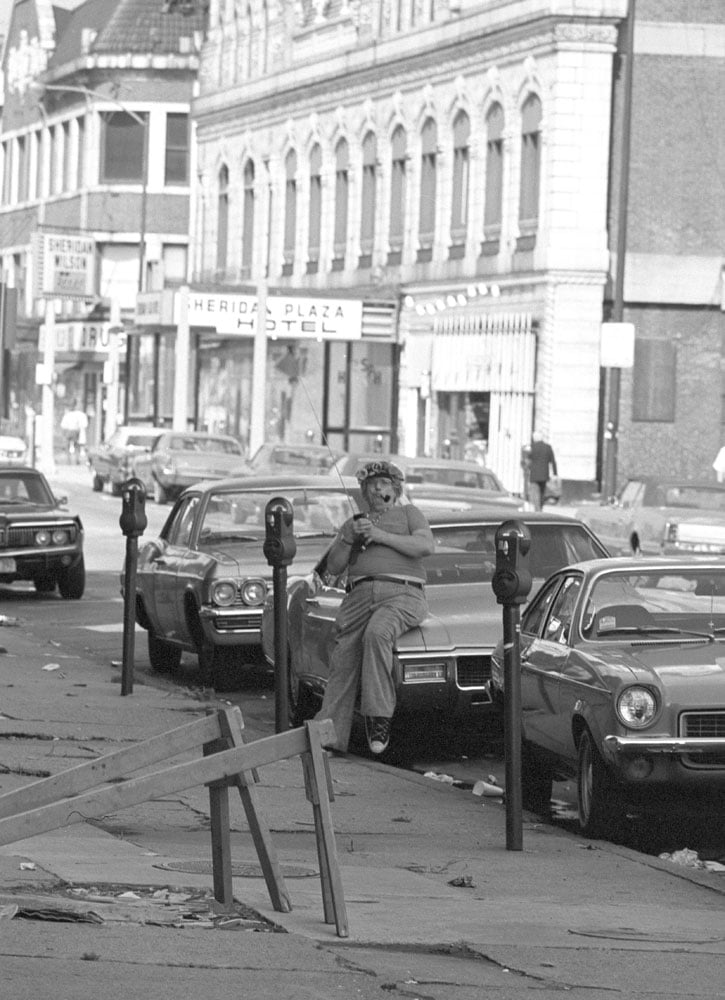
Walkie Talkie Man
This shot was taken near the intersection of Wilson and Sheridan, down the block from the Sheridan Plaza Hotel (in background). The man sitting on a parked car was talking to someone with his walkie-talkie; cell phones had not been invented yet. The sidewalk badly needed repair – like most of Chicago’s Uptown neighborhood in the mid-1970s.
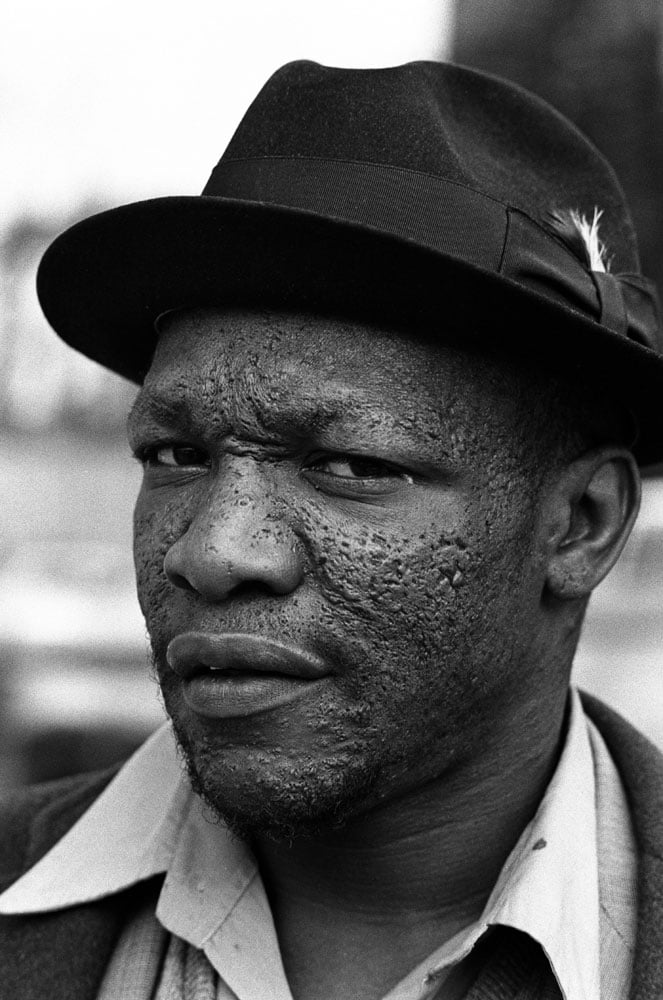
Outward Appearances
I’m not sure what causes acne like this. The effect would be devastating for most people, but it didn’t seem to bother this man much. He didn’t mind me photographing him and even signed a model release for me. Despite the fearsome appearance, he seemed like a nice man.

Father and Adopted Daughter
This image is NOT what it may appear to be. The girl’s mother came to Chicago from West Virginia looking for work. She and the girl were living on the streets when the black man took them into his home, married the mother and adopted the daughter. The Chicago Tribune Magazine published many of my Uptown images but refused to publish this one, believing that it might start a race war. Even after I told them the story, they still refused. Some years later, I showed it to a black female friend who became physically ill from looking at the image. She was deeply offended. The visceral reactions to this image among both black and white Americans tell you how deeply ingrained racism remains in American culture.

The Lone Teardrop
I took this shot on Thanksgiving morning on a wintry day in Chicago’s Uptown neighborhood. It was so cold, the heat from my body fogged the ground glass of my Rollei SL66. Only after developing the image and printing it did I see the lone teardrop in the woman’s eye. She was on her way to a shelter, where hopefully she found some Thanksgiving food. It was never clear to me whether the tear was caused by the cold or her situation.

Home Sweet Home
I found this man walking back to his Uptown apartment on crutches carrying a bag of groceries from a store that was more than a mile away. I asked if I could help him carry the groceries; he gladly took my help. I got a rare glimpse into the living conditions inside an Uptown tenement in 1974. Note the hole in wall, the bed with no sheets and the eating area with one hard, wooden chair. The floor was bare, very worn plywood. I call this image “Home Sweet Home,” Uptown-style in the mid-1970s. In truth, this was more “bare bones” than the typical Uptown apartment I saw. On the way back to his apartment, the man told me that he had been “jack-rolled by four Indians.” They had broken his ankle, then taken his wallet, his money his paycheck, his keys and his car. He had come to Chicago from Kentucky looking for work as a machine operator. But with no car, he lost his job. Then his wife left him. He tried to get on welfare, but visiting all the required offices was difficult on crutches. There were grocery stores closer to his house, but none would give him credit.

Relaxing at Wilson and Broadway
I photographed this man several times. Here I found him “relaxing” at the corner of Wilson and Broadway. Image taken in 1975. Notice how the pedestrians on the street in the background walk far away from the buildings. During this era in Uptown, this was a precaution that many people took to avoid unpleasant surprises from people who might be lurking in doorways.

Burned Out
In January of 1975, I found this burned out apartment building at 4136 North Broadway. I pitied the poor families who lost their homes. It was starting to snow and very cold out when I took this picture. Several people have asked me whether such scenes were the result of arson. I have no way of knowing in this case. Many people in the neighborhood alleged that slumlords (not in this specific case) used arson to evict residents so that they could build more expensive apartments on the property. Of course, the apartments could have burned from other causes, like space heaters, too. Uptown apartments were notoriously drafty and underheated during the mid-1970s. Note how the ruins of the apartment were not totally sealed off after the fire. Clicking on the link above will show you what the same lot looks like today in Google Maps street view. Trees have grown up around a beautiful, red-brick apartment building.

Slumlord Protest
This protest against slumlords occurred outside Northeast City College at 4522 North Racine on 2/28/1976. It was organized by the South Andersonville Improvement Association and covered by WGN-TV. At the rally, numerous residents passed out literature alleging horrific living conditions in the area’s tenements. Problems included leaky plumbing, holes in walls, rats, not enough heat, no hot water, bad odors, burned out mattresses and garbage littering property, and more. Protesters also alleged that they were charged exorbitant rents to live in these squalid conditions. The objective of the rally was to get the City to enforce building code violations.

Bombed
I shot this on the southwest corner of Wilson and Magnolia on April 22, 1976. People in the neighborhood alleged the building was “bombed.” I was never able to confirm this.
However, arson in Chicago increased 182% between 1974 and 1977. The increase was so alarming that the state senate adopted a resolution on December 12, 1976, directing the Illinois Legislative Investigating Commission to explore causes and make recommendations.
The Commission’s final report in May, 1978, begins with, “The news media has made the public painfully aware of the impact of arson in Chicago’s ... Lakeview and Uptown neighborhoods. Charred shells of buildings line blocks of these communities – the sad remains of arson-for-profit schemes, indiscriminate vandalism and revenge fires.”
The 145-page report cites numerous reasons for the increase: recession; poor training of arson investigators; poor enforcement of housing codes; inadequate penalties for arsonists; a severe backlog of cases in housing court; vandalism of abandoned properties; cursory investigations; poorly staffed crime labs; legal penalties that forced insurance companies not to delay payments in cases of suspected arson; and legislative loopholes that allowed slumlords to operate for years without maintaining their properties or paying taxes.
After the Commission submitted its final report in 1978, the Legislature remedied many of these issues. The report also noted several incidents of terrorism. Between June 1975 and May 1978, it says that Chicago had at least 17 terrorist acts of arson by explosives, allegedly committed by a Puerto Rican liberation movement known as Fuerzas Armadas de Liberacion National (FALN), which translates as the “Armed Forces of National Liberation.”
House Report 106-488 from the U.S. Government Printing Office indicates that the FALN had a safehouse and bomb-making factory at 736 West Buena in Uptown.
I have no evidence that the incident shown here was related to the FALN or was even a bombing. I mention the FALN because it was a part of the milieu that affected the lives of Uptown residents during this period.
(Note: The FALN had another safe house on Lunt in Rogers Park. I lived at Sheridan and Lunt when taking these pictures. The safe house was right next door to me.)

Latin Kings with Little Kid
I found these Latin Kings playing around with a boy on the corner of Winthrop and Ainslie in Chicago’s Uptown neighborhood in 1976. Gangs were an ever-present factor in the lives of kids growing up in Uptown. In many cases, gang members were the dominant role models in the lives of kids. The man on the left described himself as a leader of the Latin Kings in this neighborhood. Note that he is wearing a shirt that says, “Unknowns.” This may have been the precursor for an offshoot (no pun intended) of the Latin Kings called the Insane Unknowns.
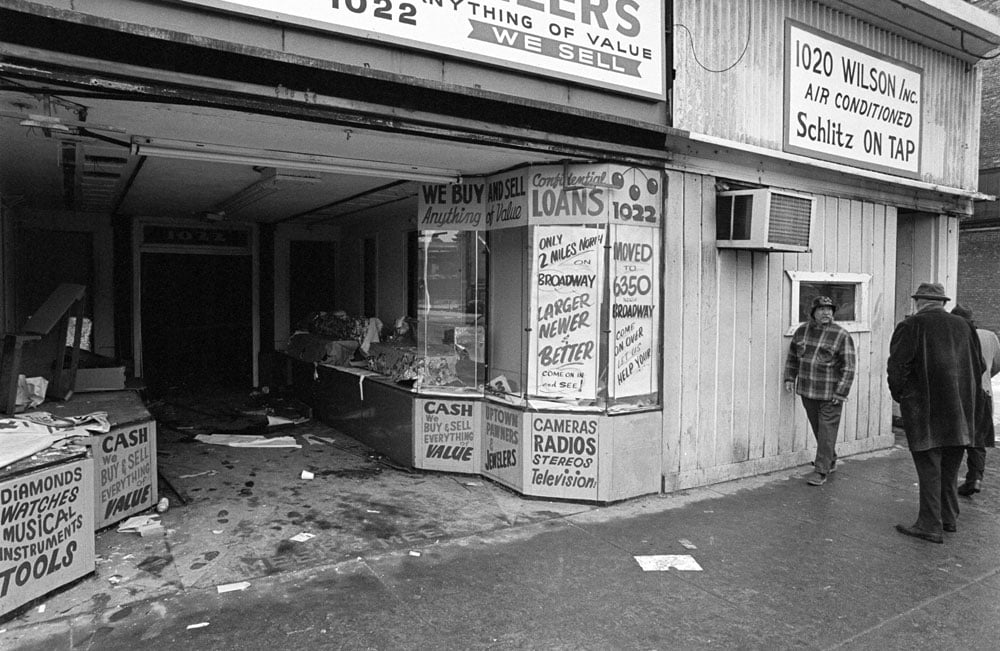
Pawn Shop Reclaimed
The Uptown Pawn Shop at 1022 West Wilson had just moved to greener pastures a couple miles north to the area just south of Loyola. It didn’t take vandals long. With the burglar bars removed, the shop was quickly looted and destroyed. The bar next door is also gone. Note how an old coat was stuffed over the air conditioner as insulation.
Today, this address is a parking lot. The bar next door is also gone.

The Professor
(A pic) “I am a rock. I am a stone. A King to the bone. I said it. I ment (sic) it. I am here to represent it.” This was text painted on this Latin Kings’ mural near the corner of Winthrop and Ainslie in Chicago’s Uptown neighborhood in 1976. Gangs like the Latin Kings had to repaint their murals frequently to cover up other gangs’ graffiti. It was a constant war of graffiti that kept neighborhood paint stores in business. Despite the misspelling, this Latin King showed a flair for poetry.

(B pic) This Latin King went by the gang name “Professor.” I took this photo near the corner of Winthrop and Ainslie in Chicago’s Uptown neighborhood in 1976. He had just painted the mural behind him which featured some poetry, a little highbrow for street gangs, even if “ment” was misspelled.

Christmas Eve at the Salvation Army
On Christmas Eve in 1974, the line to get into the Salvation Army for dinner stretched out the door and down the block. The Salvation Army did wonderful work in Chicago’s Uptown neighborhood. Were it not for them, many more people would have gone hungry.

Living and Sleeping in Car
On Wilson Avenue in Chicago’s Uptown neighborhood, I found this man living and sleeping in his car during the summer of 1974. Both the man and the car had seen better days. Enlargement will show the man is sleeping with his suitcase and a towel for a blanket. In a car of this vintage, seat belts probably would not have been installed, making it much more comfortable to lay down. The man found the right neighborhood before falling asleep. Note that he is across the street from Goodwill Industries, two bars, and a day-labor service.
(NOTE: Truman College was under construction when I took this shot. The foundation was just being poured. It was right behind me.)

Wilson Club Hotel for Men
This place used to advertise rooms for 75 cents per night. It attracted people who were “down on their luck” or who were new to the city and looking for work. It was rare to see a person this young in front of the establishment back when I took this shot in Chicago’s Uptown Neighborhood. That was in the mid-1970s. He told me he was living there while he went to vocational school; it was the only place he could afford.
A visitor to this blog emailed me this morning and said the Wilson Club Men’s Hotel was still in existence. It was old when I took this shot in the mid-1970s. Forty years later, it seems to still be going strong though a Chicago Uptown blogger posted earlier this year about aldermen who were claiming the structure was now “not fit for human beings.” The Chicago Sun-Times also published an article about conditions in the hotel. After pressure from the City of Chicago, the owner of the hotel is now looking at renovations and alternative uses for the property. In the meantime, it’s interesting to read the ratings for the hotel.

Recycling, Uptown Style
Scenes like this were common in Chicago’s Uptown during the mid-1970s. People wasted nothing. They stripped dead vehicles to keep other vehicles rolling. Recycling was done out of economic necessity, not to help the environment.
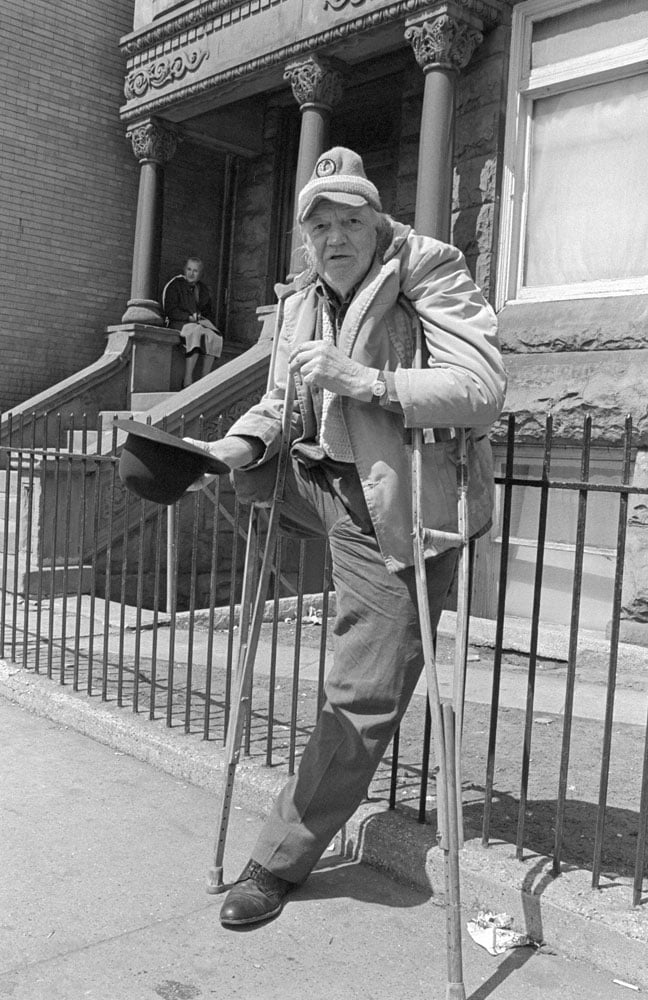
22 Years without Missing One Home Game
This amputee beggar regularly hit the streets in front of the shelter he called home. I would usually drop some change in his hat when I saw him. I always had mixed emotions about that. I suspected that the money was going for cigarettes and alcohol, not food, clothing or shelter. This photo was taken on Addison near Wrigley Field. He told me that he had not missed a home game in 22 years, and that he stood in the same spot for all of them.

Love is Blind
The image of these two teenagers amid Uptown’s squalor in the mid-1970s proves that love IS blind. They only had eyes for each other and ignored the trash and graffiti around them. Somehow it didn’t matter. They had each other.

Gun Play
A stroll through Uptown never failed to yield interesting shots. These two were playing with toy guns as virtually all boys do. However, as I took this photo, I felt uneasy. I hoped that this wasn’t an omen of things to come for these two.

Shake and Signify
Shake and Signify – The two Latin Kings in the background show the gang handshake, which mimics the points of a crown. The one in the foreground is “signifying.” Signifying is a sign of recognition. It says, “I belong to the Latin Kings.” When strangers met on a street, they would signify as a way of telling friend from foe.
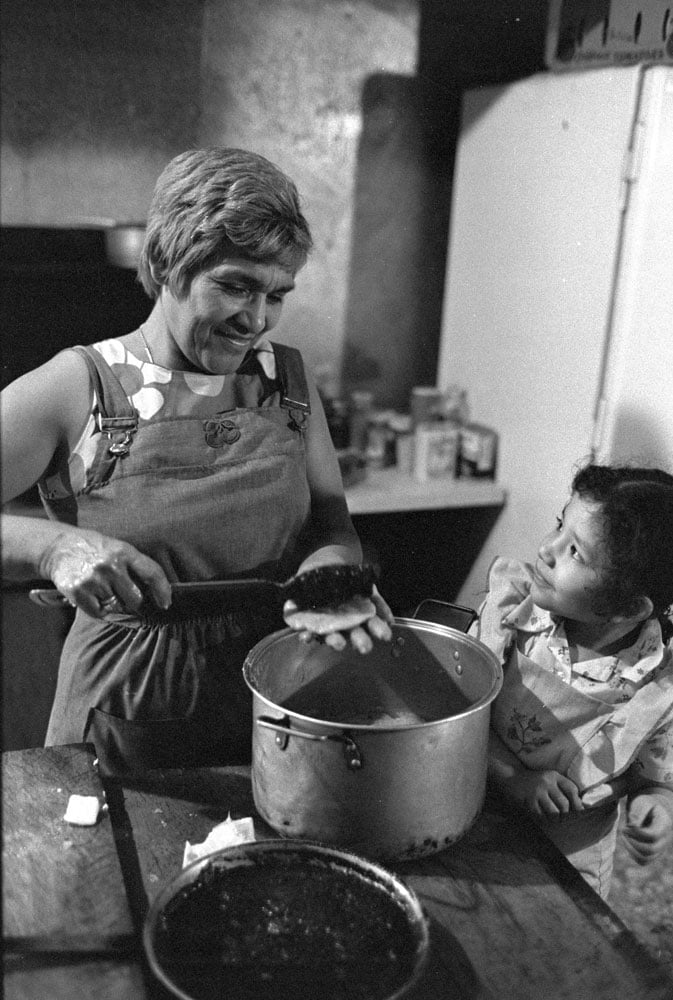
Guatemalan Restaurant
This lady ran a Guatemalan restaurant in Chicago’s Uptown neighborhood … with the help of her daughter. I stopped into the restaurant on a cold day to change rolls of film. The mother who barely spoke English invited me to take some pictures of her and her daughter preparing food. The restaurant was not busy at the time, so they insisted I sit down and have some empanadas with them. During the four years that I photographed in Uptown, I was constantly amazed at how generous the people were who had so little to give.

Best Friends
I found these two young men on Broadway, I believe. When I asked if I could take their picture, they threw arms around each others’ shoulders. They told me they were “best friends.” They almost look like brothers.
Note the shoes on these two. I took this shot in 1973. Nike running shoes had not yet been invented. Kids this age generally had two choices for footwear: Tennis shoes like the boy on the right is wearing, or more formal shoes with stiff leather uppers. Of course many kids went barefoot. Shoes were expensive on Uptown salaries. Many parents could barely afford to keep their kids in shoes, especially at this age when they were growing so quickly. Multiple pairs of shoes were out of the question.
I posted this picture previously, but am re-posting it because of a reader comment. Someone wrote in to say that the boy on the right moved with his family to Uptown from Kentucky. He had three siblings. Sadly, his oldest brother became one of John Wayne Gacy’s victims. Gacy reportedly found many of his victims in Uptown.

Social Networking Before the Internet
Few people could afford air conditioning in Uptown. On one hot summer day in 1975, these friends escaped the stifling heat in their apartment building by moving out to the balcony. Balconies were favored places for people-watching. They talked with everyone walking down the street.

New Hope
This was one of the last shots I took in Uptown. I photographed this man several times before. He was the Latin King leader. However, on this occasion, he told me he was the ex-leader. I believe he was trying to settle down for the sake of the baby. Each new child has the power to change the world. Some just take longer than others.
(Note: It’s also the last shot in the book.)
Yasmin Rammohan contributed to this report.


